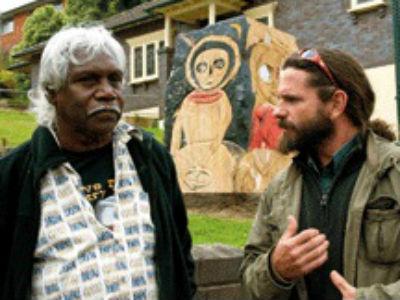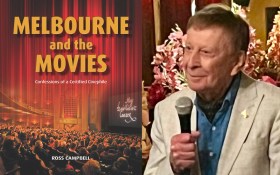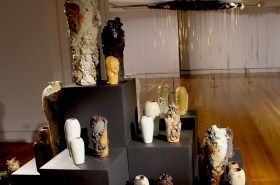The Arts Law Centre of Australia (Arts Law) provides a targeted Indigenous service to Aboriginal and Torres Strait Islander artists and their organisations through our Artists in the Black service.
But current law is often inadequate for protecting Indigenous Culture and Intellectual Property (ICIP).
Wandjina case study
In 2010, a gallery in Katoomba in the Blue Mountains in NSW erected a large sculpture featuring Wandjinas, the creation spirit sacred to the Worrora, Wunumbal and Ngarinyin Aboriginal tribes in Western Australia. Artists in the Black was contacted by both the Aboriginal people of the Katoomba area and Mowanjum Arts which represents artists from the three language groups who are the traditional custodians of the Wandjina law and sites of the Western Kimberley.
The source of this controversy was a work of art created by a non-Indigenous artist, on commission for a non-Indigenous gallery and business, which has been outspoken in its criticism of Australia’s Aboriginal people. The spirit figures depicted on the sculpture are Wandjina, a fact confirmed by the work’s title Wandjina Watchers in the Whispering Stone.
The Worrora, Wunumbal and Ngarinyin Aboriginal people of the remote Kimberley region have been painting Wandjina images for many thousands of years. They are recognised as the only Aboriginal groups entitled to depict the Wandjina and were very distressed by the Katoomba sculpture.
But whilst the Katoomba sculpture was clearly a Wandjina, it did not appear to be a copy of any particular artwork by a known artist and therefore no complaint about infringement of copyright could be made. Copyright protects individual creators of artwork. This situation concerned rights regarded as traditional or communal rights.
Nor were Australia’s consumer laws which prohibit misleading and deceptive conduct in the course of trade and commerce of any assistance in this case. Previously, this law has been used to prosecute gallery owners selling art and artefacts purporting to be Australian Aboriginal art but which had, in fact, been created by non-Indigenous artists. However in this instance because the gallery owners were in dispute with the traditional owners, it was clear that they were not trying to create a false impression that the work was authorised or created by Indigenous artists.
In this particular instance, the only way Arts Law was able to assist the traditional owners have the sculpture removed was by using the planning laws, which required council approval for a sculpture to be so located. The Council refused permission because of the adverse social impact caused by the sculpture. The case however highlighted the inadequacies of the existing legislation protecting ICIP.
Inadequacy of the existing legislation protecting ICIP
The existing legislation creating individual rights of copyright, design, patent and other intellectual property rights is ineffective to protect, much of Indigenous culture and traditional knowledge which are generally communal in nature.
There is currently no legal right of ownership of ICIP capable of enforcement by the Australian legal system. Accordingly, there is no legal obligation to respect traditional Indigenous knowledge and culture which could be the basis for mandatory standards of third party conduct. This means that souvenir businesses are free to import and sell objects decorated with distinctively Aboriginal art styles as long they do not describe them as made by Aboriginal artists. Non-Indigenous writers and dance groups can take sacred dances and stories and reinterpret them or incorporate them into their own stories and performances with impunity. Such actions are disrespectful of Indigenous culture and can cause substantial pain and anger within the Indigenous communities who are the custodians of that culture.
Why new legislation is needed
Arts Law believes that adequate protection can only effectively be achieved by separate sui generis (specific) legislation because ICIP interests are unique to other intellectual property models because ICIP:
- covers a broader range of creative, intellectual and cultural concepts than those protected under the existing copyright, designs and patent laws. ICIP should be dealt with in one piece of legislation and any attempt to deal with it solely in the context of existing legislation, for example copyright laws, will be artificial and incomplete;
- represents communal rather than individual ownership of the knowledge and culture of specific Indigenous communities;
- is an intergenerational right which is ongoing, rather than for a limited period such as life of the artist plus 70 years (copyright duration);
- is not concerned with individual originality or novelty which is the basis for all existing intellectual property rights, whether copyright, design or patents; and
- stands beside existing intellectual property rights; and is not an extension of them.
Australia has ratified the Declaration on the Rights of Indigenous People which includes article 31 requiring the Government to take effective measures to recognise and protect the exercise of … rights to maintain, control, protect and develop their cultural heritage, traditional knowledge and traditional cultural expressions, as well as the manifestations of their sciences, technologies and cultures. If Australia is to implement its obligations under the Declaration then new legislation is needed to provide the level of protection that the unique arts and culture of Indigenous people deserve in this country.
For more information about Arts Law’s work visit our website www.artslaw.com.au or Artists in the Black www.aitb.com.au.





